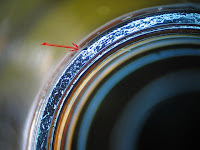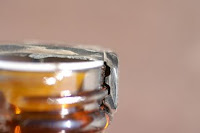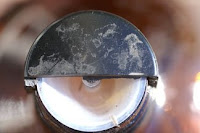Glass expert discusses a manufacturing defect that can prevent the sealing of a bottle. The client was using a Polyseal 01 with a cap to seal 750 ml bottles of a solvent. These bottles were packaged 4 to a case and sent to customers. During shipping a fixed percentage of the bottles would leak. A packaging and bottle expert examined twelve bottles submitted by the customer. Of these,two leaked. Examination of the cap and cone shaped seal found no defects. However, microscopic examination of the bottle seal surface revealed a leak path for the solvent that was molded into the top of the bottle. Top left is a top view of the polymer seal after half the cap has been cut away. Top center is a side view. The seal is effected by the cap pressing the polyseal rim down on the on the bottle top. Thus, for a good seal, the top surface of the bottle “finish” must be flat and smooth.The two leaking bottles had a “leak path” defect, and these were from the same tool cavity. The top of one of the leakers is shown in the photo on the top right. This defect is a result of a fabrication defect in the tool that forms the bottle “finish’ (ie parison tool). The client used this information with respect to the manufacturing defect (along with the tool cavity number), the bottle manufacturer was contacted and a process improvement plan was agreed upon.
Materials Failure Analysis and Process Engineering





Read Consulting Failure Analysis
Thomas L. Read, PhD,
1435 Fulton Road Santa Rosa, CA
Phone: 707-494-5089
email: info@readconsulting.com
Registered Professional Engineer
Thomas L. Read, PhD., CEO
Registered Professional Engineer
Certificate No. MF002174
State of California.


